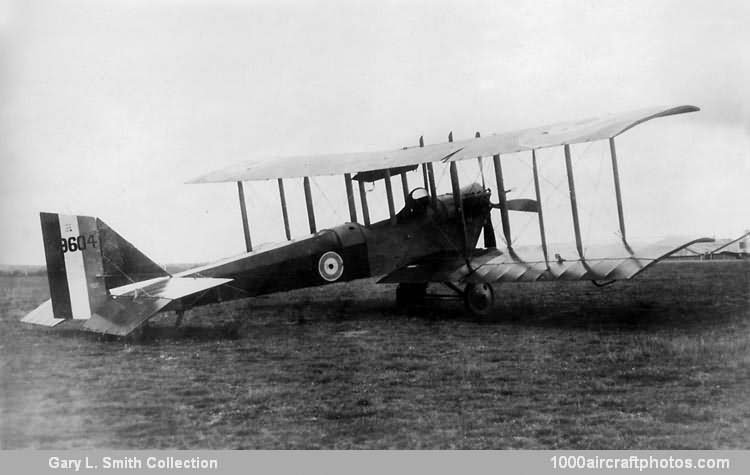The angular design was hardly attractive, but ease of production was paramount, and construction was conventional fabric covered wood with ply covering of the forward fuselage for added strength. The standard power plant was an uncowled 90 hp RAF 1a eight-cylinder air-cooled V-engine, but when D.H.6 airframe production outstripped supplies of these engines, Curtiss OX-5 or Renault in-line units were substituted.
The first production contract was for 700 D.H.6s placed on January 13, 1917 with the Graham White Aviation Company. A further 1,825 D.H.6s were produced by Airco (605 incl. two prototypes), Gloucestershire Aircraft (150), Harland & Wolff (300), Kingsbury Aviation (150), Morgan (200), Ransome, Sims & Jeffries (250), Savages (100), Canadian Aeroplanes (1), Hispano-Suiza of Spain (60 under license), while the No. 1 and No. 2 TDS' (Training Depot Station) and No. 27 and No. 35 ARD (Aircraft Repair Depot) built a total of nine from salvage and spares.
As numbers came into service rapidly, they were widely used on training duties at home, in the Middle East and Australia. Because of its viceless characteristics, the D.H.6 was considered too safe by some instructors for elementary training. Its landing speed was about 35 mph (56 kmh), and it was virtually unspinable. The controls were heavy and stability poor, and it was felt that the aircraft would not provide enough preparation for the more advanced aircraft.
Training accidents on all types of aircraft were claiming more casualties than those killed in action, but in 1918 the D.H.6 suffered a number of unexplained accidents. During the subsequent investigations it was found that the aircraft was unstable in a loop: when it reached the inverted position, even with full power, it would not continue over, but simply fell out of the sky. Recovery could be achieved by cutting the engine, but the novice pilot could not be expected to know this. By giving the wings a reverse stagger, the problem was overcome, but the aircraft became unsuitable for training, especially as the more practical Avro 504K had been adopted by this time.
With the alarming loss of coastal shipping, the D.H.6 was pressed into service on maritime patrol to try and frighten off the enemy U-boats. The D.H.6s were eventually allocated to over 30 coastal patrol flights ranging from the South West coast at Padstow right round Scotland to Machrihanish. Due to their poor load carrying capability the D.H.6s had to fly unarmed, but carried an observer who could signal with an Aldis lamp. The only recorded action was on May 30, 1918, when a D.H.6 bombed the German minelayer submarine UC 49 after it had torpedoed a ship, but it crash dived and escaped.
A total of 71 D.H.6s were allocated to Home Defence units in 1918, but their only use was as communications aircraft. With the end of the war, over 1,000 D.H.6s were still on charge and many were acquired by civil operators in the UK, Australia and South Africa, where they were used for joy-riding. It was a D.H.6 owned and raced by Airco which was allocated the first civil registration, K-100, in the spring of 1919.
Surplus D.H.6s were sold to Spain, and with the 60 license-built, remained in use as military trainers until the early 1930s. Some D.H.6s were used for civil training at Hendon, Cambridge and Bournemouth, and one with the de Havilland School of Flying survived until 1923. Rebuilt and improved versions in America were used by the barnstormers in the late 1920s. One of the last operators of the D.H.6 was Giro Aviation at Southport, who had an approval to carry two joy riding passengers in a converted front cockpit, flying thousands of passengers in this manner from 1921 to 1933."
Span: 35 ft 11.125 in (10.95 m)
Length: 27 ft 3.5 in (8.30 m)
Height: 10 ft 9.5 in (3.30 m)
Wing area: 512.3 sq.ft (47.6 sq.m)
Weight empty: 1,460 lb (662 kg)
Loaded weight: 2,027 lb (920 kg)
Max speed: 66 mph (106 kmh)
Service ceiling: 6,100 ft (1,860 m)
Endurance: 2 hr 45 min
